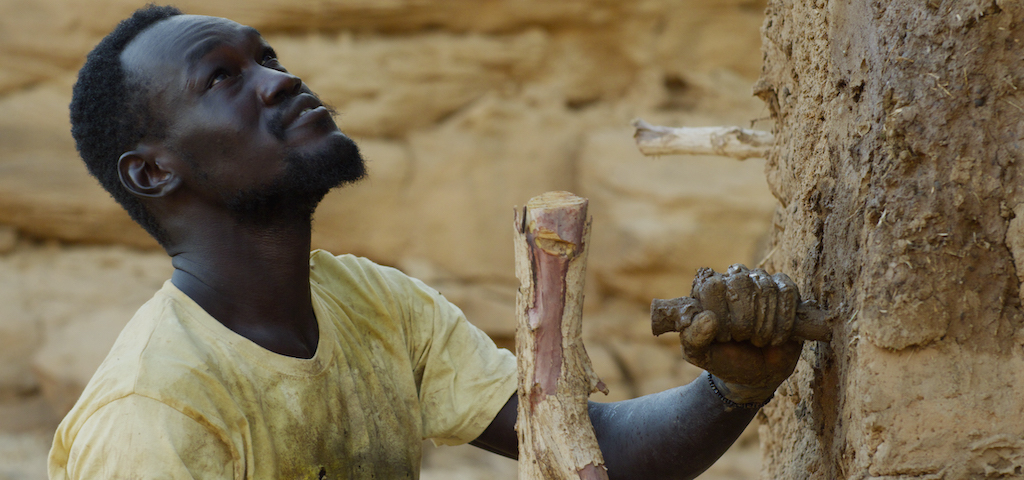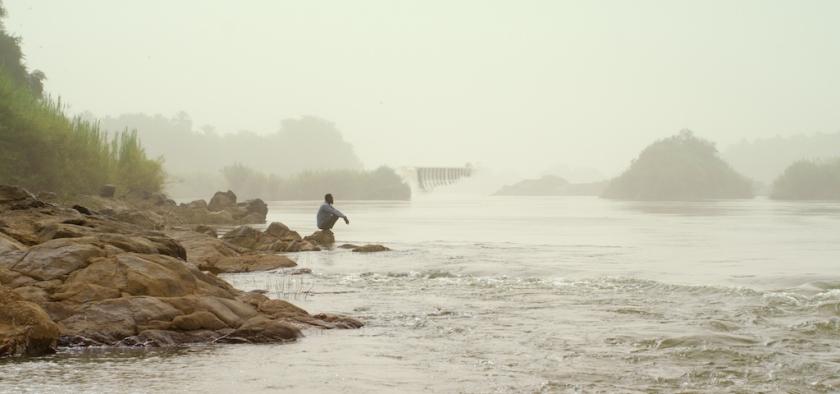Maher (Maher el Khair, an actual brick-maker) works in a brickyard sloshing sticky mud into rectangular moulds with his bare hands. Next the mud bricks are tipped out to dry in the sun, before being fired in a large, wood fired kiln. The same process has been used for centuries, yet this brickyard is within spitting distance of the Merowe Dam, a state-of-the-art hydroelectric dam built across the Nile in Sudan. Ancient and modern technologies collide.
After a day spent in the mud, the men all go for a swim, except Maher who borrows a motorbike and rides off into the desert. Driving along a dirt track through a surreal landscape of pyramids and weird rock formations, he arrives at his destination. And in the next sublime shot, the artist’s eye of director Ali Cherri – who was artist-in-residence at the National Gallery in 2021 – comes into its own. Cast onto the pale sand, Maher’s shadow reveals him to be standing on makeshift scaffolding plastering mud onto a lumpy tower. This structure turns out to be his obsession; every day he comes to build up a form which, with branches for arms, looks a little more alive with each visit.
Then Maher has a dream. Walking through a forest, he comes across a Golem, a mud creature similar to the one he is building. “Why are you chasing an impossible dream?” it asks him. “It’s taking you on a perilous journey; but at the end, you’ll find nothing.”
Maher and the other brick-makers live in primitive reed shacks in the middle of nowhere. The slaves building the pyramids probably lived like this, except that to keep abreast of what is happening in the outside world, Maher has a radio, TV and mobile phone. And in Khartoum, all hell is being let loose. It’s 2019 and demonstrators are on the streets chanting “Freedom, Peace, Justice. Revolution is the people’s choice.”
A general strike is called and the demonstrations get larger and more violent, until the military steps in to arrest President Omar al-Bashir and bring the revolution to an abrupt halt. Despite that, an air of optimism prevails. Sitting in the dark, Maher listens to the radio. “The revolution gave rise to a new generation of young men and young women who want to build a new Sudan,” says the commentator. “This movement is a revolution of consciousness. It is a permanent, ongoing revolutionary movement.” The brickyard operates in a marginal realm where time has stood still, yet Maher harbours hopes and dreams, just like the revolutionaries. By juxtaposing life in the brickyard with events in the capital, Cherri has created a remarkably haunting allegory. And the timing of the film’s showing in the UK – with power struggles raging in Sudan once more – makes the message of this little gem all the more poignant.
The brickyard operates in a marginal realm where time has stood still, yet Maher harbours hopes and dreams, just like the revolutionaries. By juxtaposing life in the brickyard with events in the capital, Cherri has created a remarkably haunting allegory. And the timing of the film’s showing in the UK – with power struggles raging in Sudan once more – makes the message of this little gem all the more poignant.
Maher is troubled by a strange wound in his side and, in the final moments of the film, it miraculously heals. This is not to suggest that all is well, though. The ending may be euphoric, but it is also ambiguous. There’s release, but whether into death or renewed life is an open question.
- The Dam is showing at the ICA on Tuesday May 9th with a Q&A with Ali Cherri
- More film reviews on theartsdesk















Add comment